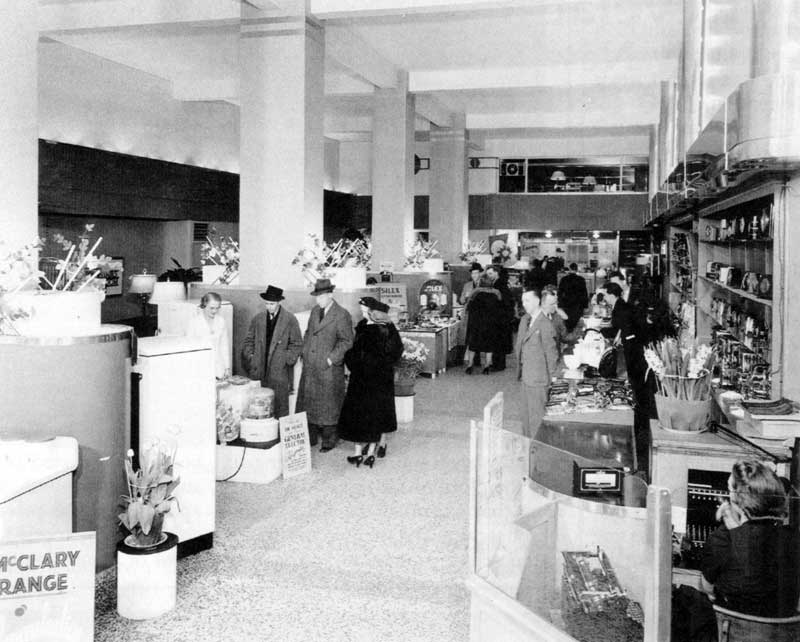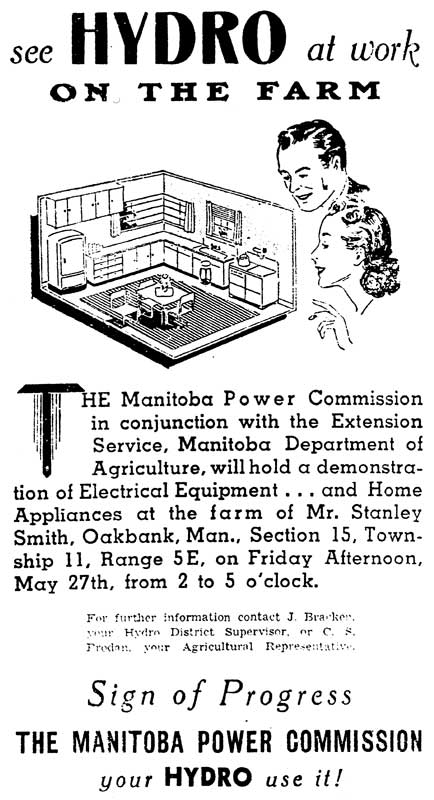by Jenara Franklin
Winnipeg
Number 48, Autumn/Winter 2004-2005
|
The kitchen, lovingly known by all as the heart of the home, is often bustling with activity, the stove overflowing with pots, the oven popping out cookies and the smell of home cooked food wafting through the air. With the advent of electricity all of this warmth became much more accessible to the citizens of Manitoba. It is important to reflect on how electrical utilities aided domestic duties in the realm of modernizing the kitchen. This piece is a reflection on areas that assisted the household in purchasing electrical appliances and creating delectable meals. The two hydro utilities that are discussed are Winnipeg Hydro, as an example of modernizing city homes and the Manitoba Power Commission, as an example of aiding farm women’s houses.
Winnipeg Hydro was created on 16 October 1911 when Pointe du Bois, their first generating station, went on line. At this time electric consumption consisted entirely of lighting. It was therefore necessary to do something that extended the field of domestic service. The solution was found in the active promotion and sale of electrical home appliances and later, home economists taught citizens how to use these new fangled electric appliances and produce quality foods.
Model kitchen in the Boyd Building’s City Hydro Store with home economist Nora Wilson.
In the early 1900s, no facilities existed in the private retail trade for a large-scale promotion and sale of electrical appliances. The department stores in Winnipeg had no electrical departments and the contractor-dealer business consisted of wiring, wiring supplies, lamp bulbs and some small appliances. The private retail trade could not be expected to expend large sums of money in promotional effort as the main consideration of the private merchant was the immediate profit on the sale of appliances. From Winnipeg Hydro’s point of view, the profit on the sale of appliances was a minor consideration, compared with the increase in revenue resulting from the use of appliances.
Although the sale and installation of electric ranges started around 1914, the first attempt to train electrical appliance salesmen was made in 1918. This was found to be successful and was deemed sufficient to justify the building of special showrooms on Princess Street as an addition to the main substation on King Street, which was the original space from which appliances were sold. These two stores were called the City Light and Power Appliance Stores. The Princess showrooms were completed in 1920 and the Appliance Department was organized as a separate department with full-time sales staff. In 1921 the King Street location was closed and the Princess location became the major store.
By 1935, it was apparent that Hydro would have to relocate the showroom into the main shopping centre of the City. On 8 June 1935, a new showroom was opened in the Boyd Building. To mark its grand entrance into society the showroom was adorned with colourful gladiolas. This store was called City Hydro and not only sold appliances, but also housed Hydro’s first Model Kitchen and the Home Service Branch.
Betty MacKay, a woman of extraordinary culinary talent, was the first Home Economist for Winnipeg Hydro. To aid customers with the task of running a household, she published helpful hints on electrical appliances and recipes in the Hydro News. Moreover, the first household hint was “Why shed those needless tears while peeling onions? Just put them in cold water and peel them in the water.” Still valid advice for the modern cook! The premiere recipes published in October 1935 were Chocolate Surprise Cake and Cornflake Macaroons.

Inside the Boyd Building’s City Hydro Store.
The Manitoba Power Commission was formed in 1919 to supply rural areas of Manitoba with electricity. By 1920, the company had begun to supply power to various areas; the first to be signed up was Portage la Prairie, followed in 1921 by Carmen, Minnedosa, and many more. As well, the Manitoba Power Commission started up an experiment in the sale of appliances in Carmen that was quite successful and the company decided that they should create more stores. Parades were used to catch the eye of potential appliance buyers. However, due to the 1929 depression and the outbreak of the Second World War, rural electrification plans were placed on hold. After the war was over, rural electrification again started with great gusto.
The Manitoba Power Commission hired Elizabeth Goulding in 1948 as their first Home Economist. Although Elizabeth only stayed a few months with the Manitoba Power Commission, all future home economists would be called “Elizabeth.” The Home Economist wrote a homemaker column that was placed in Town and Farm as well as the MPC Bulletin. The Manitoba Power Commission produced these external newsletters to maintain and keep contact with customers. Margaret Shaw, a home economist for the Manitoba Power Commission, described the job:
The recipes used all had to be tested, and photos were taken of the finished products. There was no test kitchen in my time at the Hydro. I would buy all the supplies, bring them home, and prepare the recipes for the following month in my parents’ kitchen. My mother was often interested and helped.

“See Hydro at work on the farm,” Transcona newspaper, 19 May 1949.
The end result of Elizabeth’s work of testing recipes was a column entitled Around Home. The column provided recipes, household advice, party entertainment ideas and information on electrical appliances.
Although the Around Home column promoted electricity and provided aid to farmer women, there was still a void. Margaret voiced her concern:
It can be seen that this work, which took a large part of the home economist’s time, brought very little direct contact with farm wives. There was some contact by mail as women were encouraged to write Elizabeth with questions or recipes.
Farm women were isolated on farms and were hard to contact even after the Manitoba Power Commission had hired a Home Economist, unlike Winnipeg Hydro’s model kitchen where it was convenient for city women to go and discuss concerns with the home economists. The Manitoba Power Commission had to get around the distance of its clientele, for farm women bought things, but not much and not often; a trip to town or to the country store at the crossroads was an occasion. The Commission then tried to come to the farmer through appliance catalogues for the convenience of shopping at home, the company newsletter for advice, and an exciting event known as Field Days. Farmers offered their farms and residences to the Manitoba Power Commission for them to spread the word about electricity to other farmers in the vicinity. This was termed a Field Day and was a way in which farm men and women could easily access information. Margaret Shaw provided insight into the Field Days:
In 1951 there were 13 of us in the crew. At the Field Day we set up a farmhouse, and took turns demonstrating how the various appliances worked. The farmers’ wives who were hostesses on Field Days were special people. The days were quite a bit of work for them, and they let crowds of neighbors wander through their homes for most of the day.
Field Days, although quite a labourious task, were one of the ways in which farmers could truly see electric power at work. It was an informational environment that they would feel comfortable in, unlike the farmers having to travel to the city to see a mock display. The functionality of Field Days would have definitely bolstered the desire for what appliances to buy for the farm and the farmhouse. Farmers, as well as having read about the event in the paper, would have seen the Manitoba Power Commissions travelling display vehicle if they lived along the same road as the Field Days’ host.
Both Winnipeg Hydro and Manitoba Power Commission are now incorporated into Manitoba Hydro, respectfully in 1961 and 2002, although Manitoba Hydro neither sells appliances nor staffs a home economist area. We still may have heard stories of how our grandmother mastered these modern electrical conveniences. However, we still enjoy the wonderful smells of our favorite foods simmering over the stove in our home.
Before and after electricity.
Page revised: 8 September 2010